Prosper Career Development Pilot: Ensuring a Diverse Cohort
Posted on: 26 May 2022 by Dr. Andrew Holmes in Blog posts

As 75 postdocs from our three partner institutions join our second career development pilot, we reflect on the recruitment process and the make up of the final cohort.
When applications to take part in Prosper’s second postdoc career development pilot opened back in September 2021, we wanted to build upon the success of our first cohort (read all about the cohort’s achievements in our blog post here). Our aim was to recruit a diverse pool of up to 90 postdocs from across Lancaster University, the University of Liverpool and the University of Manchester to co-create Prosper with us through a programme of intensive career development.
With our second cohort now underway it’s time to reflect on the 6-month process that led us to this point and enabled us to recruit an exciting cohort that represent the broad diversity of postdocs across the UK.
The Recruitment Journey
Preceded by a communications campaign to raise awareness across the three partner institutions, recruitment for the second cohort opened on the 1 September 2021. Over the 2.5 week recruitment window the Prosper team ran four virtual drop-in sessions, with members of Cohort 1 providing first-hand accounts of their experiences as part of the pilot. Attendance at these drop-ins was spread across the three partner institutions, with 49 postdocs joining the sessions (8 Lancaster University, 12 University of Liverpool, 23 University of Manchester, 6 unknown).
The initial recruitment window closed on the 17 September 2021 with 100 applications – 20 Lancaster University, 20 University of Liverpool, 60 University of Manchester. A key aspect of receiving a diverse pool of candidates was that we took an active approach to monitoring data by discipline, gender and ethnicity at all stages of the process. This enabled us to make the decision to extend out recruitment window when we had under representation of applicants in key areas.
Recruitment reopened for an additional week to increase application numbers broadly whilst also particularly aiming to increase the number of applications from postdocs in the Arts, Humanities and Social Sciences and from women in Physical and Environmental Sciences and Engineering, as well as from under-represented groups.
When the recruitment period ended on the 27 September 2021 we’d received 120 applications and successfully increased the proportion of applications from our targeted groups.
Based on our experiences of Cohort 1 we established eligibility criteria for participation in the pilot:
- Applicants must be employed by one of the three partner institutions on a research-only contract, and must not be employed on independent or tenure track fellowships.
- Applicants must have a contract that lasts until at least 1 September 2022 or beyond, meaning a minimum of 6 months participation in the pilot.
Of the 120 applicants that applied, 111 were eligible (26 Lancaster University, 23 University of Liverpool and 62 University of Manchester). From our benchmarking in mid-2021 we’d established that whilst there was a total postdoc population of close to 2,000 across the partner institutions, 666 of those postdocs met our eligibility criteria, meaning that one sixth of the eligible population of postdocs applied to take part in the pilot.
The applications were reviewed by a diverse panel from across the partner institutions and beyond. The panel consisted of members of the Prosper Project Board, Principal Investigators, representation from employer partners and the universities’ Organisational and Research Development and Diversity and Equality teams, and a postdoc representative from the University of Edinburgh. Applicants were selected based on their ability to demonstrate why joining the pilot at this stage in their careers would benefit them, as well as showing how their specific circumstances and experiences would contribute to the co-creation of Prosper, ensuring Prosper is flexible, accessible and appealing to the broadest possible range of postdocs.
Ultimately, 86 postdocs were successful, with 75 joining us at the launch of Cohort 2 in February 2022 (16 Lancaster University, 18 University of Liverpool, 41 University of Manchester). Whilst we experienced a higher dropout rate between offering postdocs places on Cohort 2 than for Cohort 1 (86 offers) and the final cohort (75 participants), communications from those postdocs who withdrew their applications suggests that many of them withdrew because they were offered new jobs. As frustrating as it might be to have a smaller cohort than planned, we’re thrilled that those postdocs have been able to make positive progress and take the next steps in their careers and we wish them luck.
Ensuring a diverse cohort
Prosper aims to be open, useful and relevant for all postdocs. To achieve this, our recruitment processes have had aspirational minimum targets for gender, ethnicity and disciplinary background representation. Our targets are a reflection of our previous postdoc population benchmarking work using Higher Education Statistics Agency data to look at the national picture and the three Prosper partner institutions.
Minimum targets:
- At least 20% representation from each of the three broad disciplinary areas.
- Overall 50-50 gender representation, with further gender by disciplinary area targets:
- Biomedical and Biological Sciences – 50% female / 50% male.
- Physical and Environmental Sciences and Engineering – 30% female / 70% male.
- Arts, Humanities and Social Sciences – 60% female / 40% male.
- At least 25% representation from BAME postdocs.
We also entered the recruitment process with an eye to other diversity characteristics, such as disability, caring responsibilities and sexual orientation, to ensure our final cohort reflected the broad diversity that we know exists in the postdoc population. We also aimed to recruit at least 25 participants from each of the three partner institutions.
Our targets are set for overall representation across both of our cohorts and in this blog we’ll be reflecting on how we matched up to the targets both for Cohort 2 by itself and across both Cohorts (check out our reflections on the recruitment of Cohort 1 here).
Institutional Make-Up
Out of our final 75 Cohort 2 participants, 16 are from Lancaster University, 18 from the University of Liverpool and 41 from the University of Manchester. The original target – a minimum of 25 participants from each of the three partner institutions – was based on a cohort size of 90 participants, but with our lower cohort size the revised target is a minimum of 21 participants from each institution. The numbers from Lancaster University and the University of Liverpool are still below this target, by 5 and 3 participants respectively.
However, whilst it is disappointing to have fallen short of our targets for Lancaster University and the University of Liverpool, our benchmarking in the summer of 2021 revealed that the proportion of Cohort 2 participants is broadly in keeping with the eligible populations of postdocs at the three partner universities.
As the largest of the three partners, the University of Manchester has 57% of the total population of eligible postdocs across the three institutions, whilst Cohort 2’s University of Manchester makeup is 55%. Conversely, Lancaster University only has 16% of the total eligible postdoc population across the partners, but Lancaster University postdocs make up 21% of Cohort 2. We therefore exceeded our benchmarking predictions for Lancaster University, despite falling short of our target.
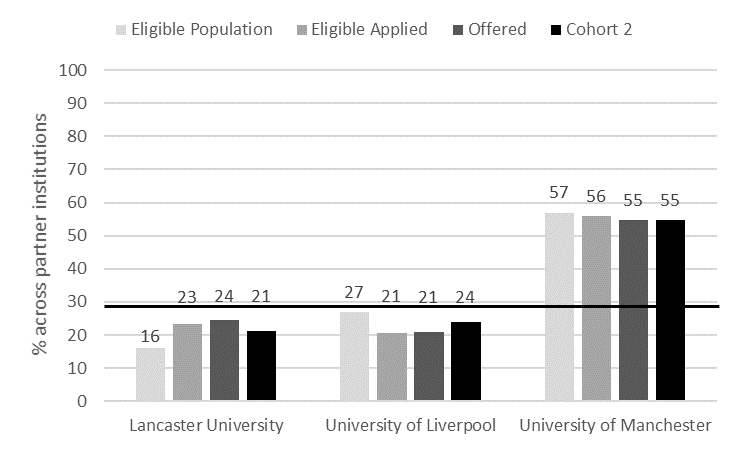
Figure 1: Bar chart showing that postdocs from the University of Manchester make up the majority of the postdoc population across the three partner institutions at every stage of the recruitment process.
Discipline Make-Up
For Cohort 2 we exceeded our aim of at least 20% representation of postdocs from each of the three broad disciplinary areas: Arts, Humanities and Social Sciences (23%), Biomedical and Biological Sciences (51%), and Physical and Environmental Sciences and Engineering (27%).
This is particularly satisfying when considering the Arts, Humanities and Social Sciences for two reasons. Firstly, the proportion of Cohort 2 participants in this discipline (23%) far exceeds our benchmarking of the total eligible population in this discipline (14%). Secondly, this helps to address the limited numbers of Cohort 1 participants from this discipline (9%), which whilst exceeding the benchmarking figures at the time is still lower than we’d have liked (you can read the discussion about this in the blog post for Cohort 1).
Representation from Physical and Environmental Sciences and Engineering (27%), whilst comfortably above our target (20%), is considerably lower than our benchmarking figures (47%). It is possible that postdocs within some subjects (e.g. engineering) in this broad disciplinary area feel they have clear routes to careers beyond academia and find jobs in industry, thus feel themselves less in need of career development in comparison to postdocs from other disciplines.
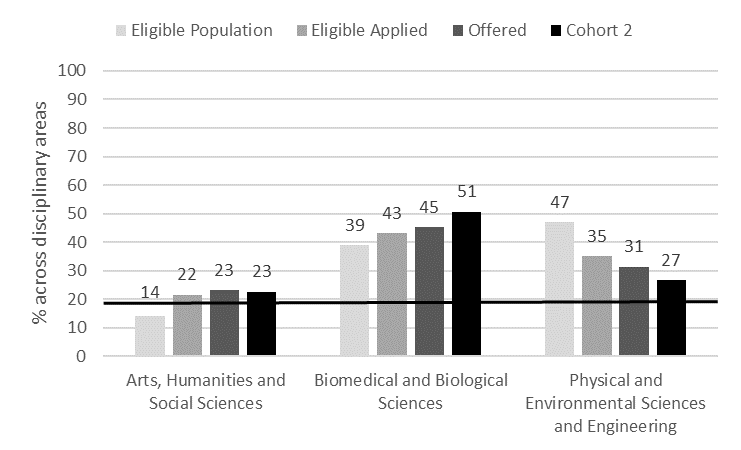
Figure 2: Bar chart showing that the percentage of Cohort 2 postdocs from each disciplinary area exceeds the 20% representation target.
Overall, when considering both cohorts, the target of 20% representation from all three broad disciplinary areas was achieved for Biomedical and Biological Sciences (55%) and Physical and Environmental Sciences and Engineering (28%). Participation across both cohorts from Arts, Humanities and Social Sciences postdocs fell slightly short of the target (17%) but did comfortably exceed our benchmarking figures.
Gender Make-Up
When considering gender, 64% of the 75 participants of Cohort 2 are female whilst 36% are male. This represents an over-recruitment of female postdocs when compared to our 50:50 gender ratio target. Combined with Cohort 1 (53% female) this means that the overall gender representation for the pilot cohorts stands at 59% female and 41% male. Curiously, this is exactly the opposite to the findings from our most recent benchmarking exercise for postdocs across the three partner institutions (41% female, 59% male). Previous research has attributed the increased participation of women in career development programs to them seeking out sources of career advice and support to counterbalance inequalities arising from unevenly distributed informal career advice by PIs and institutions.
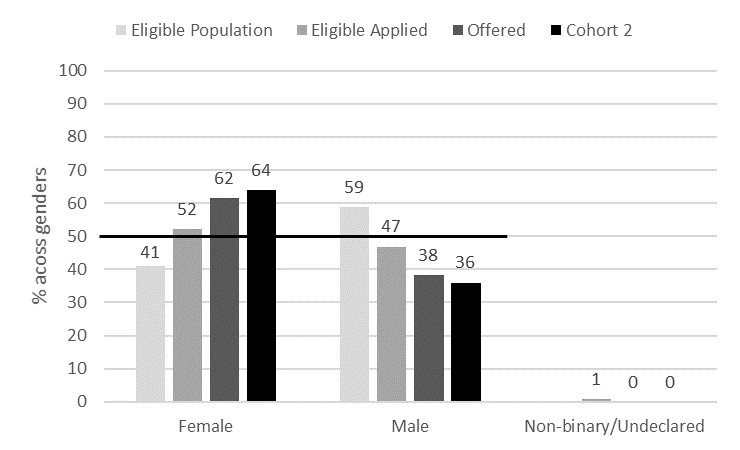
Figure 3: Bar chart showing that the percentage of female postdocs on Cohort 2 is far higher than in the postdoc population across the three partner institutions. No non-binary/undeclared data was available for benchmarking.
Whilst a higher proportion of female postdocs applied to take part in the pilot compared to males, the largest difference between the genders occurred during the assessment stage. The gender breakdown for all eligible applications was 52% female and 47% male (with 1% non-binary or undisclosed). Yet women performed more strongly during the assessment, with the distribution of places offered at 62% female and 38% male. Whilst out woman-majority cohorts align with educational and institutional policy initiatives aimed at improving women’s access to career development opportunities, we acknowledge out failure to achieve our 50:50 female:male target. We need to reflect on this result to ensure that the ultimate Prosper model of career development is attractive to all postdocs whatever their gender/gender identity.
Looking at gender distribution by discipline, female participation in Cohort 2 exceeded our targets for all three broad disciplinary areas: Arts, Humanities and Social Sciences (target 60%, Cohort 2 76%), Biomedical and Biological Sciences (target 50%, Cohort 2 71%), and Physical and Environmental Sciences and Engineering (target 30%, Cohort 2 40%). The trend of women performing better than men at the application assessment stage held true across all three disciplinary areas, with the percentages for Biomedical and Biological Sciences and Physical and Environmental Sciences and Engineering showing particularly high increases.
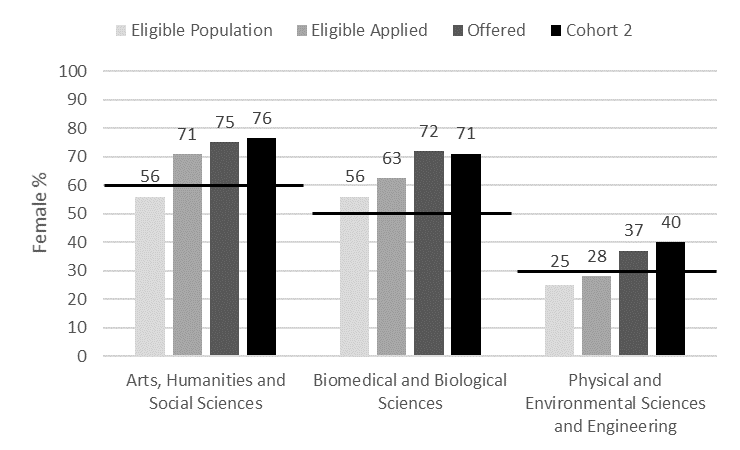
Figure 4: Bar chart showing the percentage of Cohort 2 female postdocs in each disciplinary area is greater than the targets set for those disciplines.
The Cohort 2 figures echo the recruitment achievements of Cohort 1 for Arts, Humanities and Social Sciences (60% female) and Biomedical and Biological Sciences (71% female), resulting in Prosper exceeding the overall targets for these disciplines (73% and 71% female respectively). Female representation in Physical and Environmental Sciences and Engineering was lower in Cohort 1 (12% female), and Cohort 2 went some way to addressing this deficit. Across both cohorts, 27% of postdocs from Physical and Environmental Sciences and Engineering were female, slightly short of our target of 30% but above the numbers of female postdocs in this discipline identified during our benchmarking exercises.
Ethnicity Make-Up
Of the 75 members of Cohort 2, 67% self-identified as white, 32% identified as one of the ethnic groups that comprise the broad BAME category, whilst 1% chose not to disclose this information. These results show that we comfortably exceeded our minimum target for BAME representation (25%), as well as our benchmarking (29% of the eligible population of postdocs at the three partner institutions identify as BAME).
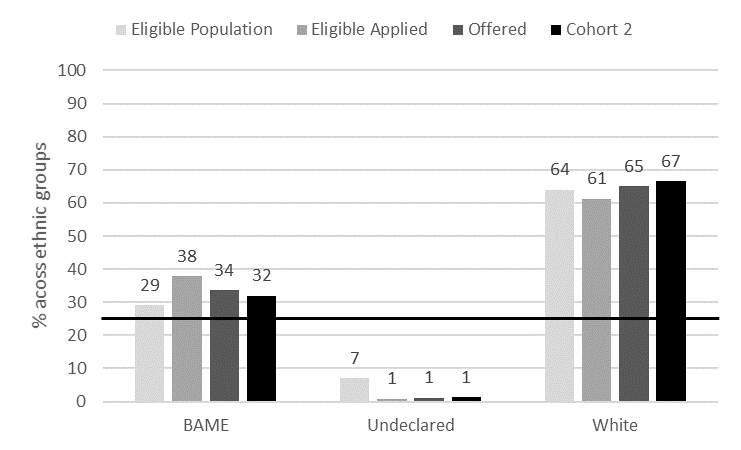
Figure 5: Bar chart showing that Cohort 2’s percentage of postdocs from ethnic groups that comprise the broad BAME category exceeds Prosper’s minimum target.
BAME colleagues face barriers to engagement with career development opportunities and during the recruitment process for both cohorts we took steps to particularly target BAME postdocs, including engaging with BAME staff networks. We’re pleased to report that we exceeded both the benchmarking figures and our target of a minimum of 25% representation from BAME postdocs: postdocs identifying as BAME make up 30% of participants across both cohorts.
Other Characteristics
One of Prosper’s 3 Pillars concerns the democratisation of access to career development and the postdoc population has a broad range of characteristics and experiences. Whilst we did not set specific targets, we believe it’s important to record representation beyond our main targets.
At least 11% of Cohort 2 declared some form of impairment, health condition or learning difficulty, a level in keeping with Cohort 1 (10%) and higher than the 4% currently declared amongst postdocs across our three partner institutions. Disability figures are self-declared and generally underrepresent the real picture; it’s encouraging that our postdocs feel comfortable to divulge this about themselves and that our cohort has such representation of postdocs with these characteristics.
The Office for National Statistics reports that in 2019 2.7% of the UK population aged 16 years and over identified as lesbian, gay or bisexual. As with the disability figures we’re pleased that the proportion of postdocs in Cohort 2 identifying as lesbian, gay or bisexual is higher (6%).
Postdocs in Cohort 2 represent a range of age groups and experience. The majority of Cohort 2 are between 31 and 40 (69%), with 25% of the cohort aged 30 or younger and a further 5% between 41 and 45 years old. The age of postdoc also correlates with their time spent as postdocs: 72% of Cohort 2 have worked as postdocs for 3 years or less, whilst 10% have spent 10-19 years as postdocs.
As the figures for postdoc age suggest, many postdocs are at a point in life when caring responsibilities may have an impact on career development. Reflecting this, we’re pleased to report that our cohort members also represent these issues, with 25% of Cohort 2 declaring that they have caring responsibilities. Potentially linked to this, 15% of Cohort 2 work part time.
Diversity Across Both Cohorts
We feel that both the design and execution of the recruitment process for Cohort 2 was broadly successful, maintaining or improving on the successes of our recruitment for Cohort 1.
Table 1: Table comparing postdoc percentages for Cohorts 1 and 2 individually and combined against Prosper's targets.
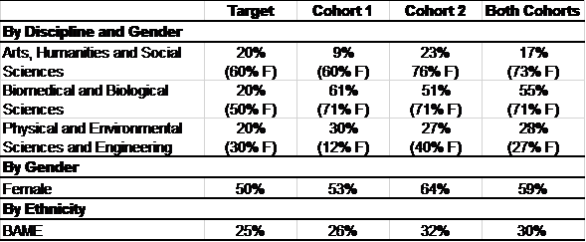
Where we fell short of our main targets – representation from institution (Lancaster University), discipline (Arts, Humanities and Social Sciences), gender (women in Physical and Environmental Sciences and Engineering) – we exceeded our benchmarking figures in every case.
We’re excited about all the different perspectives that the members of Cohort 2 will bring to co-creating Prosper in the most inclusive way.